|
|
|
Sort Order |
|
|
|
Items / Page
|
|
|
|
|
|
|
| Srl | Item |
| 1 |
ID:
115329
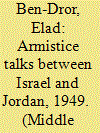

|
|
|
|
|
| Publication |
2012.
|
| Summary/Abstract |
The article examines the armistice talks between Israel and Jordan (March-April 1949) from the perspective of the UN mediator, Ralph Bunche, who coordinated them. The period described was stormy and complex: at its start, Israel took control of the southern Negev. Later, the two countries conducted formal talks in Rhodes, under Bunche's watchful eye, in parallel to informal negotiations, without UN involvement, in Jordan. The article, based to a large extent on Bunche's unpublished diary, explains why Bunche, who maintained rigorous control of all of the other armistice talks, behaved differently in this case, giving his post factum seal of approval to the Israeli takeover of the southern Negev and allowing Israel to pressure Abdullah to hand over the Triangle. The thesis is that Bunche, who could have put an end to the talks by resigning, or drawn the US into the crisis (as he did in the other rounds of negotiations), recognized the complexity of the relations between Israel and Abdullah and chose to act in a way that would prevent a new eruption of hostilities. In effect he was protecting Abdullah, who would have been likely to lose the West Bank to Israel in another round of fighting.
|
|
|
|
|
|
|
|
|
|
|
|
|
|
|
|
| 2 |
ID:
115335
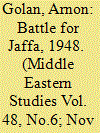

|
|
|
|
|
| Publication |
2012.
|
| Summary/Abstract |
Modern armies conduct military operations in urban areas, but rarely do so willingly. Military commanders prefer fighting in open terrain in which forces freely maneuver and use firepower, rather than in urban areas in which obstacles such as tall buildings, narrow streets, and non-combatants hinder control of the battlefield. Most professional military literature recommends refraining from fighting in urban areas and considering urban battles an unfortunate aberration to be avoided in the future. Deliberate choice of an urban battlefield is quite exceptional, deriving mostly from strategic needs or due to the symbolic value ascribed to a particular city or town. Most decisive battles of the first Arab-Israeli war in 1948 were fought in open areas. However, strategic and political considerations, as well as cultural and sentimental, caused both sides to fight in cities and towns, such as in the case of Jaffa and Tel Aviv metropolitan area, Palestine's major economic center and a main road junction. Both cities also held sentimental value: the dynamically developing modern Jaffa was a symbol of an emerging Palestinian nation while Tel Aviv, the "first Hebrew city," was the Zionist ideal of urban development.
|
|
|
|
|
|
|
|
|
|
|
|
|
|
|
|
| 3 |
ID:
115332
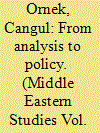

|
|
|
|
|
| Publication |
2012.
|
| Summary/Abstract |
Turkish area studies in the US developed in parallel with the diplomatic rapprochement between Turkey and the US after the Second World War. This article scrutinizes the relation between Turkish studies and American public diplomacy in Turkey with special emphasis on the latter. Unlike cultural programmes in Europe, which focused on satisfying intellectuals' taste for high culture, in Turkey the concentration of the cultural activities was on bureaucrats, educators and technical personnel. The article argues that this was because of a modernization approach and the priority given to the needs of US aid programmes. Following the revolutions in Asia, the programme was further oriented to strengthen the collaboration between Americans and the technocratic elites of Turkey.
|
|
|
|
|
|
|
|
|
|
|
|
|
|
|
|
| 4 |
ID:
115328
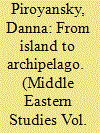

|
|
|
|
|
| Publication |
2012.
|
| Summary/Abstract |
This article circulates between three levels of inquiry and their interweaving - the personal, the local and the national. It draws on several historical dimensions - military, legal, political, sociological, architectural and cultural. In different ways, all these interlinked fields of human action are reflected in the private history of one particular house, built in the 1930s by Khalil Sakakini in Qatamon, Jerusalem. By examining both discursive and material aspects of the house and neighbourhood, the various mechanisms through which Arab property was brought, in the aftermath of the 1948 war, under Israeli control are revealed, some state-orchestrated and preconceived, others more spontaneous and based on individual and collective tendencies and preferences.
|
|
|
|
|
|
|
|
|
|
|
|
|
|
|
|
| 5 |
ID:
115330


|
|
|
|
|
| Publication |
2012.
|
| Summary/Abstract |
This article discusses how the discourse of 'Anatolia, the loveable and beautiful' was developed after the retreat of the Ottomans from the Balkans and how Anatolia emerged as the construction site of the Kemalist project of 'national modernity' and 'Anatolian enlightenment'. Based on a meticulous reading of the ethnographies, histories and monographs on Anatolian cities and regions published between 1923 and 1950 as well as the journals of the local branches of People's Houses, the article demonstrates how the regime attempted to establish its legitimacy by incorporating the local elements into the 'grand national narrative' and nationalizing the Anatolian countryside.
|
|
|
|
|
|
|
|
|
|
|
|
|
|
|
|
| 6 |
ID:
115334
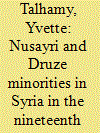

|
|
|
|
|
| Publication |
2012.
|
| Summary/Abstract |
In October 1831 Muhammad Ali Pasha's army under the command of his son, Ibrahim Pasha, attacked Greater Syria, where he faced little resistance. By May 1832 Muhammad Ali and the Sultan signed the K¨tahya peace treaty, and the region of Greater Syria became formally part of Muhammad Ali's domains, in which he decided to implement several reforms. One of these reforms was disarmament and conscription. As a result several revolts erupted in the region of Greater Syria; the two most important revolts were those of the Nusayris and the Druze, two heterodox religious minorities. The Nusayri revolt erupted in September 1834 and lasted for nine months until the rebels were fiercely subdued, disarmed and conscripted. After subduing the Nusayris in October 1835, the Egyptians conscripted the Druze of Mount Lebanon. Although the Druze resisted the orders, they lacked leadership and thus were easily disarmed and conscripted. The main revolt of the Druze was in November 1837 in the Hawran region, where the Druze put up a fierce fight against the Egyptians. Even though the Druze were subdued after almost nine months, they obtained a lenient agreement in which they were released from conscription and only partly disarmed.
|
|
|
|
|
|
|
|
|
|
|
|
|
|
|
|
| 7 |
ID:
115331


|
|
|
|
|
| Publication |
2012.
|
| Summary/Abstract |
Kazakhstan and Uzbekistan became independent upon the breakup of the Soviet Union. Neither of these republics developed strong nationalist identities and it has been the task of their former communist leaders who are still in power to develop such identities while suppressing internal divisions. Kazakhstan and Uzbekistan have had a history of tolerance toward their respective Jewish populations, from which many have immigrated to Israel (and the United States) in recent years to unite with family or for economic reasons. Those republics view Israel Diaspora Jews as a source of investment and technological know-how as well as an avenue for better relations with the United States. Conversely, Israel, while considering Russian sensitivities in its relations with Central Asia, values the region as a market for Israeli products, a source for hydrocarbon resources and a way to counteract Iran as well as to seek a more favourable attitude in disputes with the Arabs.
|
|
|
|
|
|
|
|
|
|
|
|
|
|
|
|
| 8 |
ID:
115333


|
|
|
|
|
| Publication |
2012.
|
| Summary/Abstract |
Tyrannicide, that is, assassinating one's own leader in order to take over the government and/or to dramatically influence policy, carries multiple difficulties and mortal perils for the people involved. One of them has to do with a latent danger which may only come into view after a successful assassination, followed by a takeover of the government by the assassin or people ideologically close to him; the new elites, after overthrowing the old ones, may be exposed to the same fate of violent removal. This may open a Pandora's Box of murders and counter-murders that tyrannicide perpetrators will undoubtedly wish to avoid. Given this fact, some assassins (and/or their ideological cohorts) invested a lot of time and effort to rigorously explain why this specific leader, and no other, could and should be killed. Why their assassination is unique and justified, while similar behaviour by others is not. Hence, the ideological structures behind tyrannicide are not only intended to justify it in the simple sense of the word, but also to prevent it from repeating itself endlessly. These elaborate ideological structures, and, more specifically, the form they took in the thought of two Egyptian radical Islamic writers, Sayyid Qutb and Abd al-Salam Faraj, are the locus of our discussion in the present paper.
|
|
|
|
|
|
|
|
|
|
|
|
|
|
|
|
|
|
|
|
|